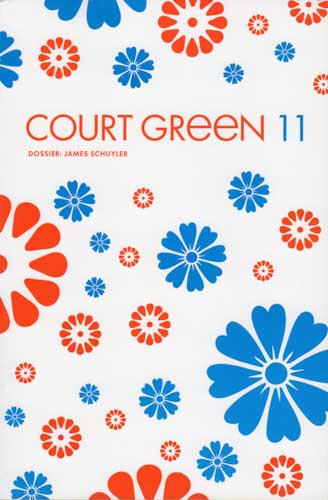Court Green – 2014
Journals published annually like Columbia College of Chicago’s Court Green find themselves in the unenviable position of trying to capture and sustain a reader’s good will and attention during the long wait between issues. Court Green makes all this look easy, staying fresh in mind on the strength of its lively, unpretentious poetry and the unique artifact its editors create with each issue’s “dossier” on a special theme or topic. This year’s “dossier” on New York School poet James Schuyler, which takes up roughly half of the issue, truly harnesses the unique potential of the format, drawing together poetic homage, letters, photographs, flyers, the reflections of associates and admirers, as well as a small selection of Schuyler’s uncollected poems. This enigmatic bundle paired with over one hundred pages of new poems by an array of established and idiosyncratic poets is sure to demand prime coffee table real estate in perpetuity.
Journals published annually like Columbia College of Chicago’s Court Green find themselves in the unenviable position of trying to capture and sustain a reader’s good will and attention during the long wait between issues. Court Green makes all this look easy, staying fresh in mind on the strength of its lively, unpretentious poetry and the unique artifact its editors create with each issue’s “dossier” on a special theme or topic. This year’s “dossier” on New York School poet James Schuyler, which takes up roughly half of the issue, truly harnesses the unique potential of the format, drawing together poetic homage, letters, photographs, flyers, the reflections of associates and admirers, as well as a small selection of Schuyler’s uncollected poems. This enigmatic bundle paired with over one hundred pages of new poems by an array of established and idiosyncratic poets is sure to demand prime coffee table real estate in perpetuity.
A definite highlight of the “dossier” is Bill DeNoyelles’s reflection on a parting of ways which occurred between him and the poet and served as the inspiration for Schuyler’s poem “One of My Favorite Gardens.” Accompanying Schuyler on his weekly trek to the psychiatrist’s office, DeNoyelles and the poet find themselves compelled to pause beside a Manhattan church where a stark, white statue of the Virgin Mary and an immaculate churchyard garden stand beneath an apple tree. DeNoyelles warmly recalls the unspoken acknowledgement that passed between them during this brief pause in their day: “He spoke of the roses there, knowing their names and origin, momentarily lost, entranced by the garden’s simple yet varied beauty. The noise of mid-day Monday Manhattan receded as we enjoyed a moment of secular meditation.” DeNoyelles’s reminiscence coupled with Schuyler’s exquisite poem offers an intimate glimpse into the process by which Schuyler transformed experience into art.
Another gripping bit of ephemera contained in the “dossier” was a collection of photographs taken by Schuyler on an August 1968 road trip around Nova Scotia with friend and poet Kenneth Koch and his family. Schuyler’s photographs of Koch’s family and the dreamy Nova Scotia landscape are paired with the reminiscences of Koch’s daughter Katherine, who remembers “Jimmy” and her parents as “good travelers” who were always “ready to be wowed.” One particularly captivating photograph was a profile shot of the thirteen-year-old Katherine engrossed in the reading of a teen fan magazine article about the Doors in the backseat of the car. There’s something endearing and hilarious about imagining Schuyler stuck in the backseat like one of the kids, snapping pictures on a road trip with someone else’s family.
While the first-hand documents from Schuyler and his coterie are undoubtedly the most memorable parts of the “dossier,” some of the poetry inspired by Schuyler is quite good too. Whether these poems are offering thoughtful commentary on Schuyler’s work or musing in his mode, they’re infectious precisely because they betray the intense personal connection these readers of Schuyler’s work have felt. Shanna Compton’s “White Chrysanthemums,” Peter Davis’s “Help Wanted,” and Catherine Bowman’s “Schuyler’s Flowers” were among my favorites.
Court Green’s latest issue also contains an exceedingly entertaining collection of poems by Amy Gerstler entitled “Fifteen Prayers,” which will have you singing its praises to friends and family. Accompanied by the humorously literal drawings of Gail Swanlund, Gerstler’s poems deal with wearying exposure to the trials and charms of the secular world and the hints of spirituality to be found there. In her poem “The Devouring and the Devoured (Blind Date)” a dinner companion rides a train of thought off the rails, unreeling a monologue about the dreary and pleasant qualities of chewing:
As a kid,
I’d repeatedly dream a giant was eating me.
In a sandwich. Do you think that’s sexual?
I could feel the slices of bread I was squashed
between, like the textured walls of my parents’
den, chafing my skin. I could feel the giant’s
teeth pressing into me. I guess I wanted to believe
I was coveted meat. . . .
Hopefully these delicious poems from Gerstler are part of a forthcoming book.
Elsewhere in the issue, Hannah Gamble captures the wistful melancholy of two-wheeled transport in her evocative poem “I Think of My Bicycle As a Kind of Horse,” Rebecca Hazelton objectifies a husband like a 1980s video vixen in her brash and spirited poem “My Husband,” and Cate Marvin explores the nervy self-centeredness of babies in her poem “Next of Kin.” In many ways, these poems driven by such strong personalities vigorously engaged with their surroundings typify the voices to be found in Court Green’s latest offering. These poets are a thoughtful, acerbic, humorous, and humane bunch, and James Schuyler is their leader.
[www.colum.edu/courtgreen]





